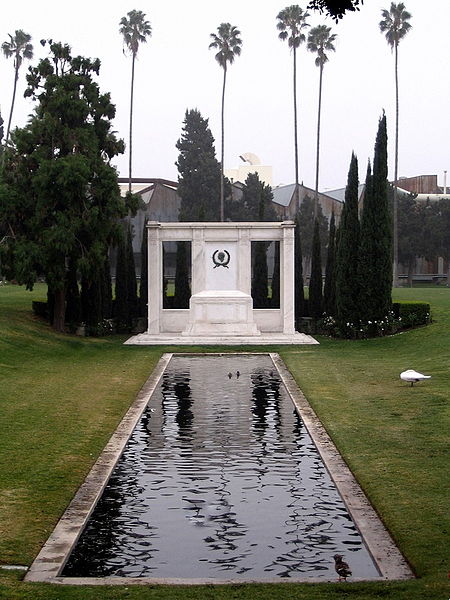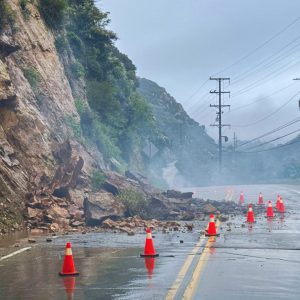 View Winners →
View Winners → 
The Hollywood Forever Cemetery was designated a historic-cultural monument by the Los Angeles City Council Tuesday following a unanimous recommendation from the city’s Cultural Heritage Commission.
The cemetery was included in the National Register of Historic Places in 1999, the cemetery’s 100th anniversary. On June 25, Councilman Mitch O’Farrell began the city’s effort to include the cemetery on its own list of historic-cultural monuments. The Cultural Heritage Commission considered the property on Oct. 21 and recommended the City Council add it to the list.
“I was surprised that this wasn’t already on our list. … It’s always interesting when something comes before us that you think, `That’s not a monument yet?”‘ Commissioner Richard Barron said during the meeting.
The monument designation was recommended for the cemetery’s association with the early development of Hollywood and the western expansion of Los Angeles during the 20th century, as well as for its association with the development of the cemetery industry and Jewish burial facilities in the city.
The commission also said the cemetery represents one of the earliest and most stylized examples of lawn-park cemetery designs in Los Angeles and a notable work of cemetery planner Joseph Earnshaw.
Heather Goers, senior architectural historian of Historic Resources Group, spoke to the commission about the significance of the Hollywood Forever Cemetery before it voted to recommend the property’s designation. She noted that the period of significance for the property spans from 1899, the cemetery’s establishment, to 1941, when the Douglas Fairbanks Monument was erected. That monument was designed by Howard Seidell of the Georgia Marble Company and was erected two years after the actor’s death.
Goers noted that much of the cemetery’s early decades were caught up in litigation, so Earnshaw’s vision wasn’t executed immediately, and much of the cemetery’s period of growth occurred in the 1920s.
Character-defining structures include the Historic Chapel designed by Hunt and Eager as part of the cemetery’s original entry complex, the Cathedral Mausoleum designed by Marston and Van Pelt, the Chapel of the Psalms designed by Frank Gibson, the Clark Mausoleum designed by Robert Farquhar, the Casket Display Room, the Bell Tower, the Abbey of the Psalms Mausoleum, and the Masonic Temple constructed in 1931 by Morgan, Walls & Clements.
As part of the cemetery’s western development, it set aside a portion of the property for Jewish burials in 1927. That year, the cemetery also began developing a mausoleum exclusively for Jewish interment.
“This really also reflected the growing Jewish community in Los Angeles, and also their westward expansion as well, as Jewish enclaves emerged in mid-Wilshire and Hollywood, other temples were constructed further westward and there was a desire to be closer to those centers of faith and to have facilities that were closer to where they resided rather than having to travel,” Goers said.
The property — located at 6000 Santa Monica Blvd., between Van Ness Avenue and Gower Street — became a tourist destination due to high-profile and celebrity burials, which began as early as 1910, when the victims of the Los Angeles Times bombings were buried in the cemetery.
“We can talk about the buildings and structures and landscape features that make this property significant in terms of its development, but one of the things that is abundantly clear in researching this property and experiencing it is its intangible connection to the history of Hollywood … the fact that those burials were people who helped pioneer and develop Hollywood,” Goers said.
Over its more than 120 years as a cemetery, the property has laid to rest Rudolph Valentino, Mickey Rooney, Estelle Getty, Judy Garland, Griffith J. Griffith, Cecil B. DeMille and more.
Goers added that many of the celebrities who were buried at the cemetery in its early years could have chosen more established cemeteries but decided to “be buried instead in the community that they helped build.”
Tyler Cassity, co-owner of the Hollywood Forever Cemetery, expressed his support for the designation before the Cultural Heritage Commission deliberated.
“We are committed to the long-term care and preservation of Hollywood Forever, a cultural landmark and historical touchstone like none other,” Cassity said.
Commission President Barry Milofsky and Commissioner Diane Kanner noted the diversity of the population buried at the cemetery.
“There’s large numbers of immigrant families — Slavic, Russian, Hispanic,” Kanner said.
Milofsky added, “the cemetery is as diverse as the general population of the city, it reflects that diversity which makes L.A. unique.”







































































































